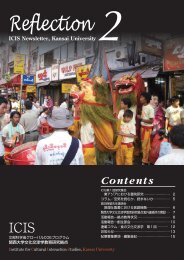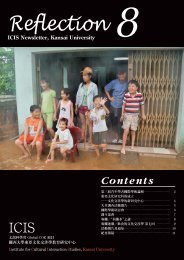English
English
English
Create successful ePaper yourself
Turn your PDF publications into a flip-book with our unique Google optimized e-Paper software.
ICIS Newsletter, Kansai University<br />
Some Thoughts on Bōnotsu -- A Base for<br />
Cultural Interactions and its Later Development<br />
ARATAKE Ken’ichiro (Assistant Professor, ICIS)<br />
In the process of studying historic documents in conjunction<br />
with fieldwork, I often find differences between the past and the<br />
present day. For<br />
instance, a place that<br />
used to be the center<br />
of a castle town has<br />
been converted to<br />
agricultural land, or a<br />
place where people’s<br />
living is now based on<br />
fishing used to be a<br />
commercial town.<br />
Every region has its The present-day Bōnotsu<br />
own history and various faces.<br />
In March 2010, I visited Bōnotsu on the Satsuma Peninsula<br />
(Minamisatsuma City, Kagoshima Prefecture)for the first time.<br />
My stay there was impacted by the yellow sand which was carried<br />
from the continent by strong winds blowing across the East China<br />
Sea. Apart from this weather condition, I found Bōnotsu to be a<br />
nice quiet fishing town. Actually, Bōnotsu, together with Hakatatsu<br />
in Fukuoka Prefecture and Anotsu in Mie Prefecture, was one of<br />
the so-called Nihon Sanshin, the front doors to Japan for people<br />
from various foreign countries. It was a port frequented by vessels<br />
for Japanese missions to Tang Dynasty China, a base for Wakō<br />
(Japanese Pirates)in Asia from the late medieval period, and<br />
played a significant role in the secret trading of the Satsuma han<br />
during the Edo Period. Indeed, it was the trading terminal, a<br />
strategic station in Maritime Asian.<br />
As a significant<br />
town in the history of<br />
Asian trade and<br />
Satsuma-Ryukyu<br />
relations, Bōnotsu has<br />
been accurately<br />
described by many<br />
scholars. I wondered,<br />
however, how the<br />
The East China Sea in a view from Bōnotsu town looked from the<br />
latter half of the 18th century to the beginning of the 19th century,<br />
the period when the secret trading was drastically declining. I had<br />
carried this curiosity for a long time before my trip there, and thus<br />
was eager to explore the issue.<br />
In the Bōnotsu Historical Research Center, Kishinkan, a hanging<br />
scroll displayed in a permanent exhibit seems to give us a clue. The<br />
scroll glistening and shining in front of me had been passed down<br />
by the Mori Family, a large merchant family in Bōnotsu during the<br />
Edo Period, and consisted of five separate trade invoices. All of<br />
these were dated September 1842 and submitted by merchants<br />
from various regions, who had bought some items from the Mori<br />
Family. It was impossible to trace where those merchants<br />
originated from, with one exception where the signature on the<br />
invoice said, “Shoudoya-Ichizaemon, Hyōgo”. If the region<br />
“Hyōgo” in this signature represents ‘Hyōgo-tsu’(present Kobe<br />
City), the trading must have been expanded so widely as to involve<br />
the whole of western Japan.<br />
From the Mori family<br />
the merchants bought dried<br />
bonito from Bōnotsu,<br />
Amakusa and the Gotō<br />
Islands. Kashio(bonito)<br />
from Makurazaki, a<br />
neighboring town of<br />
Bōnotsu, was well-known<br />
throughout the entire<br />
country. Moreover, the<br />
Human life-supporting Ikawa River “principal axis of the<br />
western sea”, from the Gotō Islands to Yakushima, was famous as<br />
the greatest fishing area at that time. As for the Mori family<br />
business, it is natural that they dealt with local products, but it is a<br />
little bit surprising that they also sold products from somewhat<br />
further removed regions, such as Amakusa and the Gotō Islands.<br />
However, it is not difficult to imagine how the merchants of<br />
Bōnotsu may have been at the forefront of the trading tradition in<br />
these three regions. Responding astutely to conditions inside and<br />
outside of the region, this might have provided them with a means<br />
of survival. Bōnotsu, an old front door to Asia, had thus been<br />
converted to the trading terminal of the western maritime area. In<br />
this way, a small<br />
townscape experienced<br />
the transition to the<br />
present time.<br />
A look at Tōjin machi<br />
7












